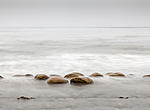Plenty of times I've composed using a flashlight or just by guessing, metered with the hyperfocal scale (with medium format) or putting my cell phone where I wanted sharp focus to be, and made an educated guess at exposure because no meter would be able to register what I could only kind of see after an hour of being out at night. When it's really dark, meters become useless. The most sensitive meter I've ever owned was a Quantum Calcu-Light XP, and even that became a paperweight after a point. Ultimately what has helped has been experimentation and guesswork. Sometimes you just have to fudge around with things until you find something that actually works.
Mario -- the chart will give you a good starting point. Michael Kenna uses 35mm and medium format, but I don't believe using a LF camera would make too much of a difference.
David -- a trick -- If a meter can almost read the available light, another way of getting a few more stops of 'sensitivity' out of the meter is to meter a white board (backside of most gray cards, or anything white, really.) Then one just adds two to three more stops to adjust for metering on something white.
Interesting trick. I'll have to try it at some point.
In these situations I've mostly just opened the shutter and listened to my ipod or taken a nap for a couple hours. A headlamp with a red LED and a kindle are also marvelous for night photography.
Mario, you can use loooong exposures even during mid sunny day (see example below). You are doing it right way. Use dslr in M mode to pickup exposure time *. After that use manufacturer reciprocity tables for your film and little bit of luck. CMOS sensors used in dslr's do not have significant reciprocity effect. I use tmax for long or multiple exposures - it has much shorter reciprocity values compared to other films.
If you are using color film - it shifts color during long exposures (dslr's don't, they just get grainy), you may compensate with color correcting filters. In color pic (bleached fujiroid negative) colors shifted towards blue, which was ok for composition, I also manually discharged handheld Canon flash (about 20 times) to highlight "bridge".
http://www.largeformatphotography.in...rs-Edge/page24
To focus during night - LED flash lights and some tape work great (I even use them in studio all the time)
* Do not not listen for dslr metering nay sayers - they do not know how to use it in M mode.
I just printed a black and white shot from the interior of a cave (lava tube) on Kauai. I could barely see anything on the groundglass itself. So I composed using a fast lens on my Nikon, noted a few relatively bright spots near the corners of the intended scene, and sorta oriented the 4x5 the same direction, sorta guessed my substantial tilts and swings, and sorta focused with the loupe on a few of those spots as best I could, and sorta guessed the reciprocity correction. Anyway, the neg turned out perfect. I don't know why.
I developed a simple spreadsheet with column A a list of shutter speeds at iso 3200 & f/4. the next column shows an equivalent shutter speed at iso 100 & f/11. So at 3200 and f/4 you can find the right actual exposure for the scene (in manual mode only) and then translate to iso 100 at f/11 without doing any mental arithmetic. If you think you won't like the resultant f/stop or shutter speed, then you can do much easier mental arithmetic from there. This is a tall thin spreadsheet taped to a tripod leg.
You can compose well enough if you have been out long enough without any light (half an hour or so) and if there is at least a cloudy full moon or a clear 1/8 moon. Focusing is the problem. If you have a near full moon and a clear night, then there is no problem with either. But of course noise becomes the next problem regardless.
John Hennessy
Bookmarks